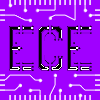What's the use of learning to solve differential equations if you don't know how to apply it to real-life situations?
Differential equations arise in many areas of science and technology. This lecture will show examples where differential equations can be widely applied to model natural phenomena, engineering systems and many other situations.
Newton's Law of Cooling
Saturday, July 31, 2010
Friday, July 30, 2010
Wye-Delta Conversion
In many circuits, resistors are neither in series nor in parallel, so the rules for series or parallel circuits described in previous chapters cannot be applied. For these circuits, it may be necessary to convert from one circuit form to another to simplify the solution. Two typical circuit configurations that often have these difficulties are the wye (Y) and delta (D) circuits.
Wye to Delta
Wye to Delta
Wednesday, July 28, 2010
Vector Multiplication: Cross Product
We define the cross product of two three-dimensional vectors a and b by the requirements:
- a × b is a vector that is perpendicular to both a and b.
- ||a × b|| is the area of the parallelogram spanned by a and b (i.e. the parallelogram whose adjacent sides are the vectors a and b).
- The direction of a×b is determined by the right-hand rule. (This means that if we curl the fingers of the right hand from a to b, then the thumb points in the direction of a × b.)
Labels:
3d,
cross product,
dot product,
Lectures,
mathworks,
Vector analysis,
vector multiplication,
vectors
Vector Multiplication: Dot Product
The multiplication of two vectors, is not uniquely defined, in the sense that there is a question as to whether the product will be a vector or not. For this reason there are two types of vector multiplication.
First, the scalar or dot product of two vectors, which results in a scalar.
And secondly, the vector or cross product of two vectors, which results in a vector.
In this tutorial we shall discuss only the scalar or dot product.
First, the scalar or dot product of two vectors, which results in a scalar.
And secondly, the vector or cross product of two vectors, which results in a vector.
In this tutorial we shall discuss only the scalar or dot product.
Labels:
3d,
cross product,
dot product,
Lectures,
mathworks,
Vector analysis,
vector multiplication,
vectors
How to Use an Oscilloscope
The oscilloscope is a particularly useful item of test equipment that can be used for testing and fault-finding a variety of electronics circuits from logic circuits through analogue circuits to radio circuits. It is necessary to know how to use an oscilloscope properly to be able to make the best use of it. By knowing the basics of using an oscilloscope it is possible to fault find circuits more effectively and more swiftly as well as gaining a better understanding of how they the circuits work.
Source: Electronic-radio
Here's a video on how to use an oscilloscope:
Source: Electronic-radio
Here's a video on how to use an oscilloscope:
Labels:
Electronics,
equipment,
laboratory,
laboratory tools,
Lectures,
oscilloscope
Matlab 7.1
The MathWorks Release 14 with Service Pack 1 CD (R14SP1) is now available. This service pack release includes major quality updates to MATLAB 7, Simulink 6, and 66 other products, as well as two new products launched since Release 14. This release also provides a 64-bit version of the MATLAB and Simulink product families for Linux based on AMD64 and Intel EM64T processors.
For more information:
http://www.mathworks.com/fp14sp1
DOWNLOAD
For more information:
http://www.mathworks.com/fp14sp1
DOWNLOAD
Differential Equations for Dummies Ebook
Increase your equation-solving skills and tackle higher-dimension math concepts!
Here's a fun and easy way to understand and solve complex equations in Differential Equations. Many of the fundamental laws of physics, chemistry, biology, and economics can be formulated as differential equations. This plain-English guide explores the many applications of this mathematical tool and shows how differential equations can help us understand the world around us. Differential Equations For Dummies is the perfect companion for a college differential equations course and is an ideal supplemental resource for other calculus classes as well as science and engineering courses. It offers step-by-step techniques, practical tips, numerous exercises, and clear, concise examples to help readers improve their differential equation-solving skills and boost their test scores.
DOWNLOAD
Here's a fun and easy way to understand and solve complex equations in Differential Equations. Many of the fundamental laws of physics, chemistry, biology, and economics can be formulated as differential equations. This plain-English guide explores the many applications of this mathematical tool and shows how differential equations can help us understand the world around us. Differential Equations For Dummies is the perfect companion for a college differential equations course and is an ideal supplemental resource for other calculus classes as well as science and engineering courses. It offers step-by-step techniques, practical tips, numerous exercises, and clear, concise examples to help readers improve their differential equation-solving skills and boost their test scores.
DOWNLOAD
Tuesday, July 27, 2010
Introduction to Electronics: Terminology
This article contains the terms that we will often encounter in the succeeding lessons in Electronics.
AC and DC
Electricity flows in two ways, either in alternating current (AC) or in direct current (DC). The difference between AC and DC has to do with the direction in which the electrons flow.
In DC, the electrons flow steadily in a single direction, or "forward." In AC, electrons keep switching directions, sometimes going "forwards" and then going "backwards." DC is the kind of electricity generated by a battery. On the other hand, the power that comes from wall outlets is AC.
AC can even be changed to DC by an adapter, such as that used to power the battery on a laptop.
Source: Wise Geek
AC and DC
Electricity flows in two ways, either in alternating current (AC) or in direct current (DC). The difference between AC and DC has to do with the direction in which the electrons flow.
In DC, the electrons flow steadily in a single direction, or "forward." In AC, electrons keep switching directions, sometimes going "forwards" and then going "backwards." DC is the kind of electricity generated by a battery. On the other hand, the power that comes from wall outlets is AC.
AC can even be changed to DC by an adapter, such as that used to power the battery on a laptop.
Source: Wise Geek
Labels:
ac dc,
bias,
diode,
ece,
electronic terms,
Electronics,
electronics engineering,
Lectures,
rectification,
terminology
Sunday, July 25, 2010
About
About the Blog
This blog is a collection of lectures on subject areas related to Electronics Engineering. This blog aims to give students a better understanding of their lessons. Just like its title, this blog will try to make Electronics Engineering subjects easier and minimize the burden of students.
Disclaimer:
Lectures, videos, pictures and all other things contained herein are taken from books and various sources in the web. References will always be acknowledged in every article. All information provided in this blog are for educational purposes only. The owner of this site does not own the rights to these properties.
About the Blogger
The owner of this blog is residing in the Philippines and she is planning to stay even after she graduates. She is currently a third-year Electronics and Communications Engineering student at the University of Santo Tomas.
She started blogging in the year 2006 but took it seriously in September 2009 when she heard about bloggers who make six figures online. She created her personal blog, "Time to Shine" with the aim of making money through SEO. Information regarding whether she was successful or not... would not be discussed in this section. :)
Besides blogging, you can also find her
Her name is pronounced as 'klom'.
And lastly, she accepts donations. :)
Subscribe to:
Posts (Atom)










